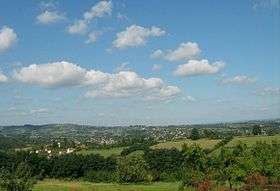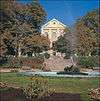List of spa towns in Serbia
This list is incomplete; you can help by expanding it.
Banja Koviljača fountain

Vrnjačka Banja stream
Spa towns in Serbia are rich in mineral water, mud, air or other characteristics that help or facilitate the discomfort, speed up healing, or recovering, or otherwise assist the healing process. There are over 40 spas in Serbia, and over 400.000 people visit it annually. Most known and visited spas in Serbia are Vrnjačka Banja, Banja Koviljača, Bukovička Banja, Sokobanja and Niška Banja.[1]
List
The following is a list of spa towns in Serbia.[a]
| Name | Location | Information | Picture |
|---|---|---|---|
| Atomska Banja | Čačak municipality, Western Serbia. |
Active spa center since 1890. It was found that the water of mineral springs are slightly radio-active. Springs (#): Temperature (°C): 29,8 |
.svg.png) |
| Banja Koviljača | Loznica municipality, Western Serbia. |
It is the oldest spa in Serbia. Springs (#): Temperature (°C): 21-38 Output (l/s): |
|
| Banja Vrujci | Mionica municipality, Western Serbia. |
Founded as National Health Resort in 1935. Also known for its medicinal spa mud. Springs (#): Temperature (°C): 27 |
 |
| Banja Kanjiža | .svg.png) | ||
| Banja Palić | .svg.png) | ||
| Banja Junaković | .svg.png) | ||
| Banja Rusanda | .svg.png) | ||
| Banja Ždrelo | .svg.png) | ||
| Banja Palanački Kiseljak | .svg.png) | ||
| Banja Slankamen | .svg.png) | ||
| Banja Badanja | .svg.png) | ||
| Bogutovačka Banja | .svg.png) | ||
| Bujanovačka Banja | .svg.png) | ||
| Brestovačka Banja | .svg.png) | ||
| Bukovička Banja | Arandjelovac, Sumadija, Serbia |  | |
| Divčibare | .svg.png) | ||
| Gamzigradska Banja | .svg.png) | ||
| Gornja Trepča | .svg.png) | ||
| Jošanička Banja | .svg.png) | ||
| Banja Kanjiža | .svg.png) | ||
| Banja Kiseljak | .svg.png) | ||
| Kuršumlijska Banja | .svg.png) | ||
| Lukovska Banja | .svg.png) | ||
| Mataruška Banja | .svg.png) | ||
| Niška Banja | .svg.png) | ||
| Novopazarska Banja | .svg.png) | ||
| Ovčar Banja | .svg.png) | ||
| Prolom Banja | .svg.png) | ||
| Pribojska Banja | .svg.png) | ||
| Ribarska Banja | .svg.png) | ||
| Sijarinska Banja | .svg.png) | ||
| Selters Banja | .svg.png) | ||
| Sokobanja | .svg.png) | ||
| Vranjska Banja | Hottest spring in Serbia | .svg.png) | |
| Vrdnik | .svg.png) | ||
| Vrnjačka Banja | Vrnjačka Banja municipality, Raška District, Western Serbia. |
Vrnjačka Banja is the most celebrated and most popular spa town of Serbia. Springs (#): Topla voda (36.5 °C), Snežnik (17 °C), Slatina (24 °C), Jezero (27 °C), Beli izvor, Borjak, Vrnjačko vrelo |
|
| Zvonačka Banja | .svg.png) | ||
See also
Notes and references
Notes:
| a. | ^ In Serbian, word for spa (banja) is almost always a part of the banja's name. If the name is given as a noun, banja precedes it (Banja Koviljača), if the name is given as an adjective (usually with the -ka suffix), banja comes after (Niška Banja). |
References:
- ↑ Top pet najposećenijih banja u Srbiji (Serbian)
External links
This article is issued from Wikipedia - version of the 6/23/2016. The text is available under the Creative Commons Attribution/Share Alike but additional terms may apply for the media files.